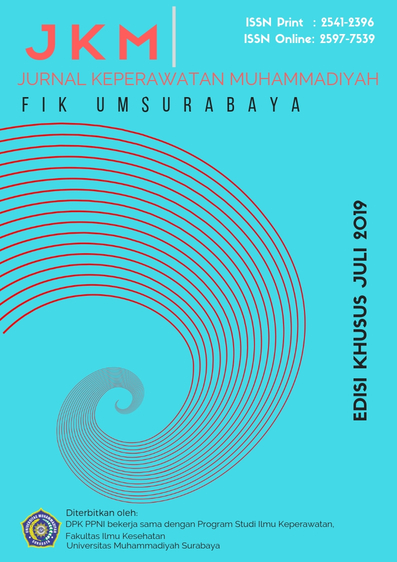Instrumen evaluasi kinerja preceptor dengan kepuasan, kepercayaan diri dan critical thinking preceptee dalam melaksanakan praktik klinik; pilot study
DOI:
https://doi.org/10.30651/jkm.v4i2.2194Kata Kunci:
Preceptorship, preceptor, preceptee, performance satisfaction, self confidence, critical thinkingAbstrak
                                                                              Abstract
Background: A preceptee require a qualified Preceptor to guide them in clinical teaching and learning activities to be more confident, satisfied with the guidance obtained and can improve their critical thinking skills in nursing action. For that we need terstandart instruments to measure it. The purpose of this pilot study was to determine the value of Cronbach's alpha instruments and understanding the structure of words contained in the instrument. Methods: a pilot study of the instrument Preceptor performance, satisfaction, confidence and critical thinking preceptee at 20 nursing students were obeying program nurses in hospitals Makassar. Results: The results obtained pilot study Cronbach's alpha values> 0.90, which indicates that the Internal Consistency good reliability, value corrected item-total correlation of each item> 0.90, which indicates that the item total correlation coefficients were very good and had a good word structure. Conclusion: Instrument performance Preceptor, Satisfaction, Confidence and Critical Thinking preceptee have internal structure of words and good consistency.
Referensi
DAFTAR PUSTAKA
Abdo, S. A. ., El-Sallamy, R. ., El-Sherbiny, A. A. ., & Kabbash, I. . (2015). Burnout among physicians and nursing staff working in the emergency hospital of Tanta University, Egypt. Eastern Mediterranean Health Journal, 21(12), 906–915.
AIPNI. (2016). Kurikulum Pendidikan Ners Indonesia.
Asriyadi, F., Suryanto, & Afandi, M. (2017). Pengembangan Alat Ukur untuk mengukur Kompetensi Preseptor di Rumah Sakit Wahana Pembelajaran Pendidikan Profesi Ners. Retrieved from http://repository.umy.ac.id/bitstream/handle/123456789/10897/13. NASKAH PUBLIKASI.pdf?sequence=13&isAllowed=y
Borsa, J. C., Damásio, B. F., & Bandeira, D. R. (2012). Cross-Cultural Adaptation and Validation of Psychological Instruments : Some Considerations, 22(53), 423–432. http://doi.org/http://dx.doi.org/10.1590/1982-43272253201314
Bradley, H., Cantrell, D., Dollahan, K., Hall, B., Lewis, P., Merritt, S., … White, D. (2015). Evaluating Preceptors. Journal for Nurses in Professional Development, 0(0), 1–6. http://doi.org/10.1097/NND.0000000000000166
Cherry, B., & Jacob, S. R. (2014). Contemporary Nursing: Issues, Trends, & Management (sixth). Missouri: Elsevier Mosby.
Kaniaru, D., Nyagena, E., Kathuri, N., & Chebor, A. (2016). Perception of Preceptor and Student Nurse Partnership on Clinical Teaching and Learning. American Journal of Nursing Science, 5(4), 141–145. http://doi.org/10.11648/j.ajns.20160504.13
Mahanani, S., Dewi, Y. S., & Soerartri, W. (2014). Analisis Kinerja Perawat Pembimbing Klinik dengan pendekatan teori kinerja dan Indikator Kompetensi. Jurnal Ners, 9, 329–338.
Nursalam. (2015). Manajemen Keperawatan Aplikasi dalam praktek keperawatan profesional. Jakarta: EGC.
Omer, T. (2016). Nursing Students ’ Perceptions of Satisfaction and Self-Confidence with Clinical Simulation Experience. Journal of Education and Practice, 7(5), 131–138.
Reghuram, R., & Caroline, P. (2014). Student Perception Of Effectife Clinical Teacher Characteristics. International Journal Of Nursing Care, 2(1), 47–50.
Sari, S. M., Ennimay, Marni, E., & Anggreny, Y. (2017). The Implementation of Preceptorsip Model Improve Competency Achievement Of Nursing Clinical Students ( Implementasi Model Preceptorship Meningkatkan Pencapaian Kompetensi Mahasiswa Profesi Ners ). Jurnal INJEC, 2, 118–125.
Shin, H., Park, C. G., & Kim, H. (2015). Validation of Yoon ’ s Critical Thinking Disposition Instrument. Asian Nursing Research, (October), 1–7. http://doi.org/10.1016/j.anr.2015.10.004
Tursina, A., Safaria, T., & Mujidin. (2016). Pengaruh Bimbingan Preceptorship Model Kognitif Sosial Terhadap Peningkatan Kompetensi Klinik pada Mahasiswa. Psikopedagogia, 5(1), 79–87. http://doi.org/http://dx.doi.org/10.12928/psikopedagogia.v5i1.4593
Zerwekh, J., & Garneau, A. . (2014). Nursing Today : Transition and trends (seventh). United states of America.
Unduhan
Diterbitkan
Terbitan
Bagian
Lisensi
- Penulis tetap memegang hak atas karyanya dan memberikan hak publikasi pertama kepada jurnal ini yang secara simultan karya tersebut dilisensikan di bawah:Â Creative Commons Attribution-ShareAlike 4.0 International (CC BY-SA 4.0)













